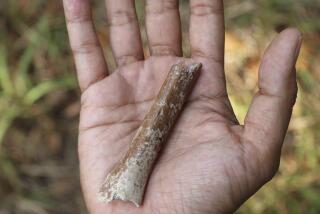Drowned dinosaur eggs’ fossil remains reveal embryos grew fast
- Share via
Scientists have discovered some of the oldest dinosaur embryos ever found — a rare collection of delicate fossils that offer an unprecedented look into the remarkably speedy early development of these enormous animals.
The bed of Lufengosaurus bones and smashed eggshell, described in Thursday’s edition of the journal Nature, may also provide some insight into the growth of birds and other dinosaur relatives.
“There’s nothing like this that has been discovered before,” said Luis Chiappe, a dinosaur paleontologist at the Natural History Museum of L.A. County, who was not involved in the study.
The hundreds of bones the scientists extracted from a nesting site in southern China provide several snapshots of embryos in different stages of development. They’re thought to hail from the Early Jurassic, some 190 to 197 million years ago.
Researchers from Taiwan first discovered the unhatched dinosaurs’ mass grave after noticing a few tiny bones dribbling out of a hillock near farming land known for producing Lufengosaurus bones. But Lufengosaurus is a huge animal, stretching up to about nine meters in length. Such small bones — some the width of pencil lead — seemed out of place, said lead author Robert Reisz, a paleontologist at the University of Toronto Mississauga.
The paleontologists followed the tiny bone trail, working on their bellies with hand tools. They carefully dug out a one-square-meter patch that turned up more than 200 bones from 20 individuals, in a spot that could have held more than three dozen eggs, Reisz said.
Lufengosaurus, early cousins of the long-necked dinosaurs like Brachiosaurus, appeared to like laying their eggs close to a water’s edge, where they would partly bury them in damp soil, Reisz said.
But living on the edge came with risks, and these eggs paid the price. The nest must have experienced a slow flood, drowning the embryos within.
The water subsided and the eggs broke up — but the sluggish flow left the remains mostly in place, creating a 4-to-8-inch-thick muddled bed of tiny bones.
Dinosaur embryo beds are exceptionally uncommon — the tiny, airy bones break up easily when an animal dies. Until now, the oldest embryos were the roughly 190 million-year-old remains of unhatched Massospondylus found in South Africa. However, those came encapsulated in their eggs, making them difficult to study.
Lufengosaurus did paleontologists a favor. Since they tended to lay their eggs in the same spot as others, they created a sort of communal nest with a sample of embryos at different stages of development.
“We started to think, ‘This is very exciting stuff,’” Reisz said. “But what do we do with it, and what kind of questions, paleontological and biological and evolutionary, can we ask?”
The scientists had a wealth of material to work with. Delicate skulls were sparse, but femurs survived well. The scientists found 24 of the thigh bones ranging in length from about a half an inch to an inch.
The bones were extremely porous, shot through with holes for blood vessels — more so than in other dinosaurs, according to the paper. Paleontologists said that was a sign the animals had been growing at break-neck speeds, since the increased blood flow would relay nutrients quickly around the rapidly developing body.
“At this stage dinosaurs grew at rates comparable to birds and mammals and much faster than other reptiles,” said Kevin Padian, a UC Berkeley paleontologist who was not involved in the discovery.
Scientists aren’t sure why the dinosaurs grew so fast, Reisz said — even faster than other dinosaurs. It could have been a defensive strategy, with shorter incubation times minimizing the risk that the eggs were exposed to the elements (such as the flood that claimed these eggs) or to predators looking for a tasty meal.
It could also explain their gigantism.
“Because these are herbivorous animals, the presumption is that they would have wanted to grow faster so they get out of the prey range of the other dinosaurs which would possibly eat them,” Reisz said.
This supercharged growth spurt in ovo appears to live on in today’s birds, which are thought to be dinosaurs’ direct descendants, Chiappe said.
The researchers also discovered that these embryos might have been kicking, just as human babies do in the womb. The scientists found ridges forming along the leg bones that are known to develop when a muscle is pulling on it.







